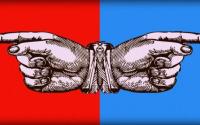14 january 2010
by Carl Lindskoog
In the hours following Haiti's devastating earthquake, CNN, the New York Times and other major news sources adopted a common interpretation for the severe destruction: the 7.0 earthquake was so devastating because it struck an urban area that was extremely over-populated and extremely poor. Houses "built on top of each other" and constructed by the poor people themselves made for a fragile city. And the country's many years of underdevelopment and political turmoil made the Haitian government ill-prepared to respond to such a disaster.
True enough. But that's not the whole story. What's missing is any explanation of why there are so many Haitians living in and around Port-au-Prince and why so many of them are forced to survive on so little. Indeed, even when an explanation is ventured, it is often outrageously false such as a former U.S. diplomat's testimony on CNN that Port-au-Prince's overpopulation was due to the fact that Haitians, like most Third World people, know nothing of birth control.
It may startle news-hungry Americans to learn that these conditions the American media correctly attributes to magnifying the impact of this tremendous disaster were largely the product of American policies and an American-led development model.
From 1957-1971 Haitians lived under the dark shadow of "Papa Doc" Duvalier, a brutal dictator who enjoyed U.S. backing because he was seen by Americans as a reliable anti-Communist. After his death, Duvalier's son, Jean-Claude "Baby Doc" became President-for-life at the age of 19 and he ruled Haiti until he was finally overthrown in 1986. It was in the 1970s and 1980s that Baby Doc and the United States government and business community worked together to put Haiti and Haiti's capitol city on track to become what it was on January 12, 2010.
After the coronation of Baby Doc, American planners inside and outside the U.S. government initiated their plan to transform Haiti into the "Taiwan of the Caribbean." This small, poor country situated conveniently close to the United States was instructed to abandon its agricultural past and develop a robust, export-oriented manufacturing sector. This, Duvalier and his allies were told, was the way toward modernization and economic development.
From the standpoint of the World Bank and the United States Agency for International Development (USAID) Haiti was the perfect candidate for this neoliberal facelift. The entrenched poverty of the Haitian masses could be used to force them into low-paying jobs sewing baseballs and assembling other products.
But USAID had plans for the countryside too. Not only were Haiti's cities to become exporting bases but so was the countryside, with Haitian agriculture also reshaped along the lines of export-oriented, market-based production. To accomplish this USAID, along with urban industrialists and large landholders, worked to create agro-processing facilities, even while they increased their practice of dumping surplus agricultural products from the U.S. on the Haitian people.
This "aid" from the Americans, along with the structural changes in the countryside predictably forced Haitian peasants who could no longer survive to migrate to the cities, especially Port-au-Prince where the new manufacturing jobs were supposed to be. However, when they got there they found there weren't nearly enough manufacturing jobs go around. The city became more and more crowded. Slum areas expanded. And to meet the housing needs of the displaced peasants, quickly and cheaply constructed housing was put up, sometimes placing houses right "on top of each other."
Before too long, however, American planners and Haitian elites decided that perhaps their development model didn't work so well in Haiti and they abandoned it. The consequences of these American-led changes remain, however.
When on the afternoon and evening of January 12, 2010 Haiti experienced that horrible earthquake and round after round of aftershock the destruction was, no doubt, greatly worsened by the very real over-crowding and poverty of Port-au-Prince and the surrounding areas. But shocked Americans can do more than shake their heads and, with pity, make a donation. They can confront their own country's responsibility for the conditions in Port-au-Prince that magnified the earthquake's impact, and they can acknowledge America's role in keeping Haiti from achieving meaningful development. To accept the incomplete story of Haiti offered by CNN and the New York Times is to blame Haitians for being the victims of a scheme that was not of their own making. As John Milton wrote, "they who have put out the people's eyes, reproach them of their blindness." Carl Lindskoog is a New York City-based activist and historian completing a doctoral degree at the City University of New York.
You can contact him at [email protected]






